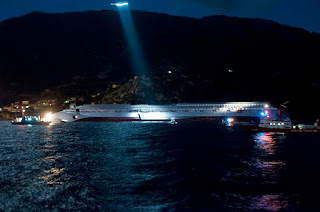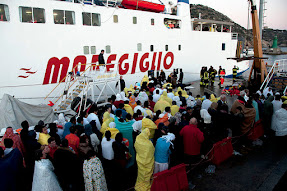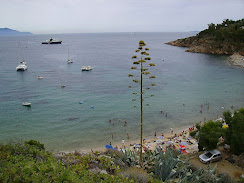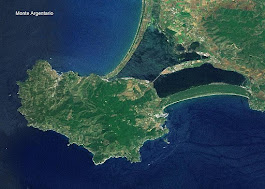Shipwreck off Tuscany coast cost 32 lives
A fatal accident involving the luxury cruise ship Costa Concordia took place on this day in 2012, resulting in the loss of 32 lives.The partially submerged hull of the Costa Concordia
off Isola del Giglio, on the coast of Tuscany
The captain, Francesco Schettino, was ultimately prosecuted and found guilty of manslaughter, receiving a 16-year jail sentence.
The tragedy began to unfold at 9.45pm as the €450 million vessel, carrying 3,206 passengers and 1,023 crew, struck rocks close to Isola del Giglio, off the coast of southern Tuscany.
The Costa Concordia, at 290m long Italy’s largest cruise ship when launched in 2005, was en route from the Tyrrhenian port of Civitavecchia to Savona in Liguria on the first leg of a seven-day Mediterranean cruise.
Its course along the Italian coastline involved passing between Isola del Giglio, an island of 23.80 sq km (9.19 sq mi), and the promontory of Monte Argentario, some 16km (10 miles) to the east, but well away from the coastline of each.
On the night of 13 January, 2012, however, the Costa Concordia deviated considerably from its normal course after Schettino ordered the ship to be steered close to Isola del Giglio in a manoeuvre known as a maritime “salute” to the island’s 1,400 residents, sounding the ship’s horns as it brushed the shore, the darkness making it a spectacular sight.
 |
| The scene off Isola del Giglio in the hours after the collision as rescuers battled to save survivors |
Spotting a reef ahead of him, linked to a group of rocks known as Le Scole, Schettino gave orders to change course but a miscommunication between the captain and his helmsman meant that the vessel was at first turned in the wrong direction. It was corrected quickly enough for the bow to be steered away from the rocks but, at a speed of 16 knots, the Costa Concordia’s stern struck the reef, opening up a 53m (174ft) gash on the port side.
The ship quickly began to take on water, flooding the engine rooms and causing a loss of power, which affected both the engines and the electricity supply on board. Damage to the rudder also meant the ship could not be steered, and the wind blew the boat back toward the island, where it eventually ran aground near the shore.
For the first half hour after the Concordia struck the reef, Schettino told the passengers on board and the coastguard, who contacted the ship after frightened passengers began to call the police, only that there was a blackout.
 |
| The route of the Mediterranean cruise that the ill-fated Costa Concordia was to have followed |
Schettino made his own position worse by leaving the bridge, reportedly at just before 11.20pm, and soon afterwards was seen in a lifeboat. Later, he claimed that he had fallen off the Concordia after losing his footing on the tilting deck and had the good fortune to land in a lifeboat. Yet, according to the coastguard, when he was ordered to return to the vessel because passengers were still on board, he refused.
By early morning, a rescue operation involving 25 coastguard boats, 14 merchant ships and many helicopters had evacuated 4,194 people before conditions forced the search to be temporarily suspended. Three more individuals, including the ship’s safety officer, Marrico Giampietroni, who had suffered a broken leg, were freed by divers later but there were no more survivors.
The bodies of most of the remaining victims were recovered by divers over the next couple of weeks but, agonisingly for relatives, some remained unaccounted for until the salvage operation was allowed to begin after 2,400 tonnes of fuel had been safely extracted from the Concordia’s tanks.
 |
| Rescued passengers waiting to board a ferry to take them to the mainland |
Criminal charges were levelled against several crew members, including Schettino. In July 2013, four crew members who entered guilty pleas in response to various charges, including manslaughter, received sentences of less than three years.
After being denied a plea bargain, Schettino went on trial charged with manslaughter, causing the wreck and abandoning ship. In February 2015, he was convicted on all charges and sentenced to more than 16 years in prison, upheld on appeal.
The cost of the disaster, including victims' compensation, refloating, towing and scrapping costs, was estimated to be around €1.75bn ($2bn), almost four times the original cost of the Costa Concordia.
Travel tip:Cannelle beach on Isola del Giglio,
a popular tourist destination
Despite its unwanted association with tragedy, Isola del Giglio retains its reputation as a beautiful destination for tourists. After Elba, the second largest of the islands of the Tuscan Archipelago, blessed with sandy beaches and isolated coves, and crystal clear waters. It has 28m of coastline, with extensive beaches at Campese, Cannelle, Arenella and Caldane, the last-named accessible only on foot or by boat. The main villages are Giglio Porto, the island’s only harbour, which has narrow streets and multicolored houses, and the charming Giglio Castello, where within its medieval walls little seems to have changed over centuries.
Travel tip:A satellite photograph that shows how much
of the promontory is covered with trees
The promontory of Monte Argentario, once an island, is linked to the southern Tuscany coast by flimsy strips of land, now covered in woodland. The pretty harbour town of Porto Ercole is a popular weekend destination with a waterfront that buzzes with summer nightlife. By contrast, much of the rest of the peninsula is quiet and rugged and notable for its mild microclimate, which allows for an abundance of plants and wildlife to thrive. Porto Santo Stefano, on the northern side of the promontory, is the largest town and is served by ferries to the Tuscan islands.
Also on this day:
1869: The birth of Prince Emanuele Filiberto, Duke of Aosta
1898: The birth of operatic baritone Carlo Tagliabue
1936: The birth of operatic baritone Renato Bruson
1950: The birth of actress and author Veronica De Laurentiis
1970: The birth of cycling champion Marco Pantani
(Pics by Paolo de Falco, Roberto Vongher, Soerfm via Wikimedia Commons)



No comments:
Post a Comment